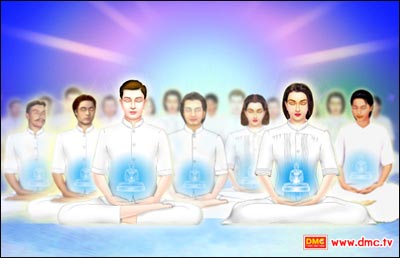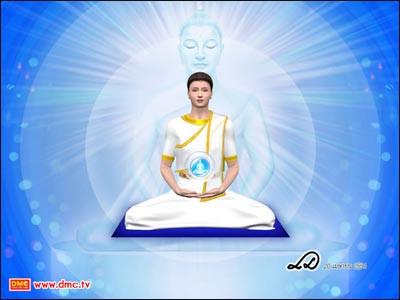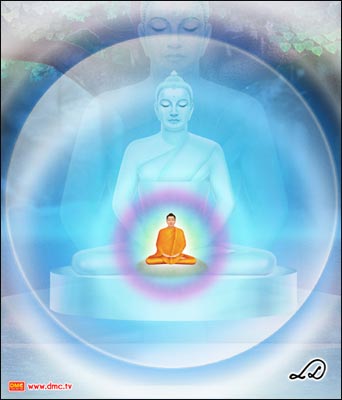The Noble Truth of the Path to the Cessation of Suffering # 5
Overcoming the Defilements in the Mind Level by Level
The Benefits of Attaining the Inner Bodies
Attaining the body in the body brings inestimable benefit to our lives vecause it is the means by which we can overcome the defilements and it allows us insight into various sorts of higher knowledge which can only be seen and known by virtue of the eyes and minds of the inner bodies:
1. Overcoming the Defilements in the Mind Level by Level
Meditatiors who cultivate themselves according to the Eightfold Path and according to the principles of the Middle Way will find that their mind becomes free of the upsand-downs of elation and disappointment. Apart from bringing them wisdom, the equanimity they discover will make them feel ‘alive’ in a way they have never felt before. It is this equanimity [upekkha] which will lead the meditator down the pathway towards Nirvana. The more the mind becomes free from defilements, the deeper inside the mind will be able to travel on the central axis through the iner bodies.
The defilements associated with the physical human body comprise covetousness [abhijjha], vengefulness [byapada] and False View [miccha ditthi]. When the mind is sufficiently pure to be released from these thre defilements, the mind will attain the Angelic Body.
When the mind is sufficiently pure to be released from
these three defilements, the mind will attain the Brahma Body.
The defilements associated with the Angelic Body are greed [lobha], hatred [dosa] and delusion [moha]. When the mind is sufficiently pure to be released from these three defilements, the mind will attain the Brahma Body.
The defilements associated with the Brahma Body are grasping [raga], hatred [dosa] and delusion [moha]. When the mind is sufficiently pure to be released from these three defilements, the mind will attain the Formless Brahma Body.
The defilements associated with the Formless Brahma Body are subtle sense-grasping [kamaraga anusaya], annoyance [patigha anusaya] and subtle ignorance [auijjaanusaya]. When the mind is sufficiently pure to be released from these three defilements, the mind will attain the first Dhamma Body [dhammakaya Gotrabhu] and that person will become a person enlightened at the level of the Gotrabhu attainer [gotrabhu puggala].
Having attained the first Body of Enlightenment, the meditator uses this Body of Enlightenment to examine the Four Noble Truths in the Physical Human Body and the Subtle Human Body both forwards [anuloma] and in reverse [patiloma]. In this way, the Sotapana Body of Enlightenment [Dhammakaya Sotapana] will be attained. That person will become a stream-enterer [sotapana]- the first level of Buddhist sainthood-who has managed to release themselves from the lower fetters of self-view [sakkayaditthi], doubt [vicikiccha] and attachment to rites and rituals [silabbatapamada].
That person will become a nonreturner [anagami]-the third level of Buddhist sainthood.
Having attained the Sotapana Body of Enlightenment, the meditator uses this Body of Enlightenment to examine the Four Noble Truths in the Angelic Body both forwards [anuloma] and in reverse [patiloma]. In this way, the meditator will manage to diminish the three fetters of grasping [raga], hatred [dosa] and delusion [moha] – and that person will attain the Sakidagami Body of Enlightenment [Dhammakaya sakidagami]. – the second level of Buddhist sainthood who has diminished the worst of grasping [raga], hatred [dosa] and delusion [moha].-and that person will attain the Sakidagami Body of Enlightenment [Dhammakaya Sakidagami]. That person will become a once-returner [sakidagami]-the second level of Buddhist sainthood who has diminished the worst of grasping [raga], hatred [dosa] and delusion [moha].
Having attained the Sakidagami Body of Enlightenment, the meditator uses this Body of Enlightenment to examine the four Noble Truths in the brahma Body both forwards [anuloma] and in reverse [patiloma]. In this way, the meditator will manage to release themselves from all five lower fetters: self-view [sakkayaditthi]. Doubt [vicikiccha], attachment to rites and rituals [silabbatapamada], sense-grasping [kamaraga] and annoyance [patigha]-and that person will attain the Anagami Body of Enlightenment [Dhammakaya Anagami]. That person will become a nonreturner [anagami]-the third level of Buddhist sainthood.
Having attained the Anagami Body of Enlightenment, the meditatior uses this Body of Enlightenment to examine the Four Noble Truths in the Formless Brahma Body both for wards [anuloma] and in reverse[patiloma]. In this way, the meditatior will manage to release themselves from all five higher fetters: grasping for the form sphere [ruparaga], grasping for the formless sphere [aruparaga], arrogance [mana], absent-mindedness [uddhacca] and ignorance [avijja]- and that person will attain the Arahant Body of Enlightenment [Dhammakaya Anagami]. That person will become an arahant –the fourth and final level of Buddhist sainthood-with no remaining defilements.
That the Buddha or the arahants are able to eradicate all the defilements from their minds is achieved by the same sequential method described above.
That the Buddha or the arahants are able to eradicate
all the defilements from their minds is achieved by the same
2. Insight into various sorts of higher knowledge
Ther are various sorts of higher knowledge which are only accessible by means of attaining the Dhammakaya. The meditator has attained the various bodies in sequence until reaching the Dhammakaya and becoming one and the same as the Dhammakaya and becoming one and the same as the Dhammakaya. The body of the Dhammakaya incorporates layers of perception, sensory registration, central processing and cognition in just the same way as the human body. By contrast however, the mind of the Dhammakaya can be enlarged to a diameter equal to the distance across the lap (knee-to –knee) of the Dhammakaya. If it is the Dhammakaya Gotrabhu, this distance measures twenty fathoms (forty metres) – and the size increases with the refinement of each new Dhammakaya attained in sequence. A ‘mind’ which can be expanded in this way is known by the special name of ‘nana’ or knowing.
The mind’s capacity to expand as ‘nana’ in this way allows the meditator clearly to examine the eight inner bodies which have already been traversed and to see that all of these bodies are subject to the Three Signs [tilakkhana]-impermanence [aniccam], suffering [dukkham] and not-self [anatta]. All this is seen by the eye of the Dhammakaya. All this is known with the knowing [nana] of the Dhammakaya. It is this practice which we can correctly refer to as ‘insight’ or ‘vipassana’. Cultivating meditation and insight further, the meditator will attain increasingly subtle forms of the Dhammakaya until reaching the Subtle Arahat Dhammakaya body. The meditator will attain the condition of ‘coolness’ [sitibhuto] – coolness from the fire of the defilements. At this point the meditator has completed the work of the mind-there is no further work to be done.
Meditation - Related Articles
" />
" />
" />
" />
" />
" />
" />
" />
" />
" />
" />
" />



![That person will become a nonreturner [anagami]-the third level of Buddhist sainthood. That person will become a nonreturner [anagami]-the third level of Buddhist sainthood.](https://images.dmc.tv/www/images/meditationNAW/img-4.jpg)





